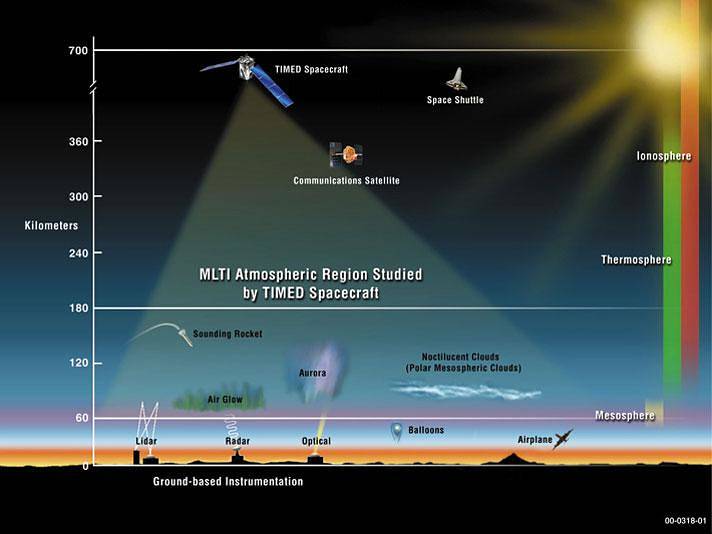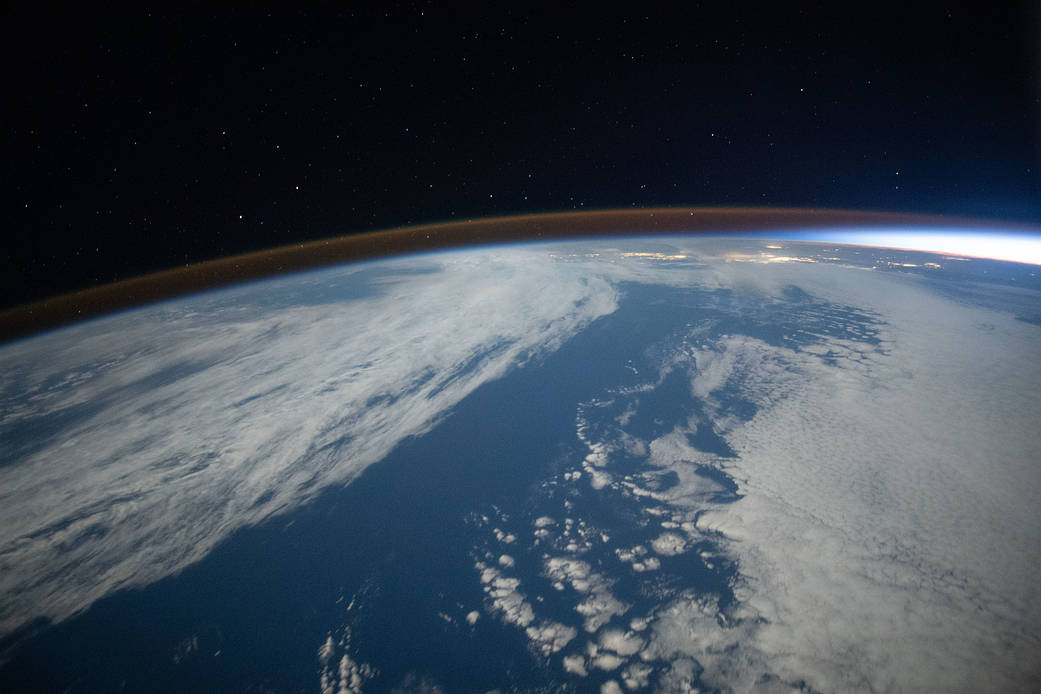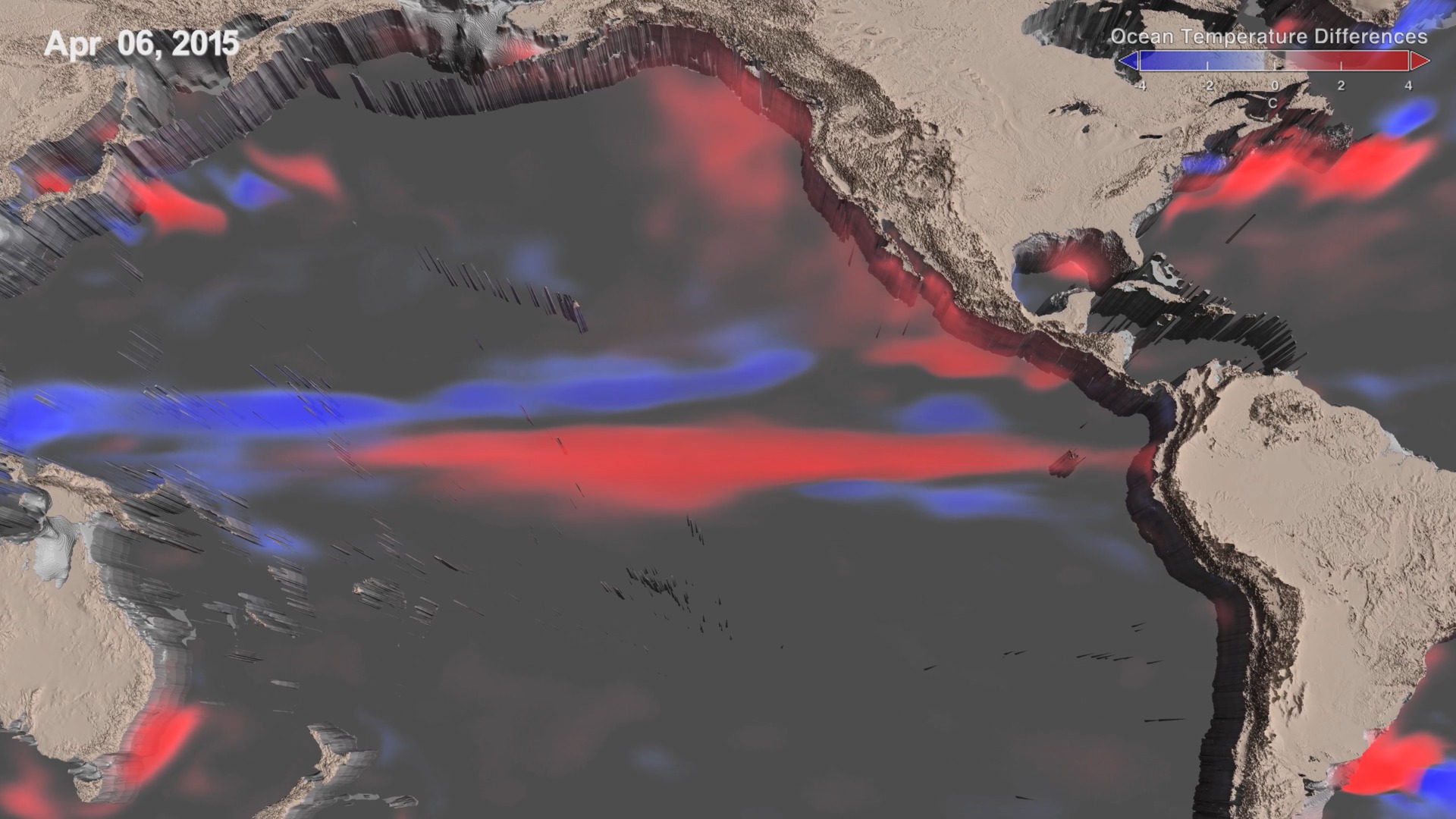So much of the well-known science on Earth’s atmosphere focuses on what’s happening in its lowest two layers — the troposphere down here where we live and work, and above that, the stratosphere, home to the ozone layer.
But 20 years ago today, scientists watched a satellite lift off that they hoped would give them a few good years of insight into the workings of two of the highest regions of the atmosphere — the mesosphere and thermosphere.
By just about any measure, the Sounding of the Atmosphere using Broadband Emission Radiometry (SABER) instrument aboard the Thermosphere, Ionosphere, Mesosphere, Energetics and Dynamics (TIMED) spacecraft has exceeded whatever modest expectations scientists had for it two decades ago. A well-built instrument on a well-built satellite, SABER is still collecting data with no signs of slowing down any time soon.
“SABER has exceeded our wildest expectations by a longshot. In addition to understanding the basic workings of the mesosphere and lower thermosphere, there have also been many unexpected findings, including groundbreaking observations of infrared radiation that are being used to develop new techniques to forecast ‘space weather,’ which is vital to protecting space assets such as the International Space Station,” said Marty Mlynczak, SABER principal investigator at NASA’s Langley Research Center in Hampton, Virginia. “Graduate students who did their doctoral work using SABER data are now university professors up for tenure. TIMED and SABER have truly touched the future as only NASA can.”
The TIMED spacecraft was built and is operated by the Johns Hopkins Applied Physics Laboratory in Laurel, Maryland. What follows are just a few of the significant and fascinating findings from SABER’s 20 years in orbit:
Carbon Emissions — An Upper Atmosphere Problem, too
SABER has observed that the rate of increase of carbon dioxide in the mesosphere and lower thermosphere is the same as at Earth’s surface. Carbon dioxide has a long lifetime and through atmospheric mixing processes eventually increases into all altitudes of Earth’s atmosphere. Infrared radiation from carbon dioxide controls the thermal structure of the mesosphere and lower thermosphere. Though carbon dioxide causes warming in the lower atmosphere, it leads to cooling in the upper atmosphere and a decrease in density at altitudes up to 1,000 km. This has significant implications for the assessment of low-Earth-orbiting satellites and space debris since the drag of the upper atmosphere decreases as it becomes less dense. With rapidly increasing numbers of satellites (and debris), the probability of collisions increases, underscoring the importance of long-term measurements.
Dune Auroras
Citizen scientists in Europe recently discovered an aurora with an appearance similar to dunes of sand on a beach — hence the name “dune” aurora. The discovery of a new type of aurora after decades of observations was unexpected and SABER data were used to diagnose the atmospheric conditions that could lead to the development of these beautiful and newly-observed aurora. Specifically, the analysis using SABER temperatures indicates that a bore — a type of wave disturbance flowing through the atmosphere below 100 km — is likely responsible for the formation of the dune auroras.
The Power of a Tsunami
During and shortly after Japan’s Tohoku-Oki earthquake on March 11, 2011, and Chile’s Illapel earthquake on Sept. 16, 2015, both of which resulted in tsunamis, SABER was viewing over the Pacific Ocean. Significant and coherent nighttime airglow events were observed in the mesosphere and attributed to tsunami-induced gravity waves that transferred energy from Earth’s surface all the way up into the mesosphere. Airglow is colorful light that emanates from the upper atmosphere. It’s not uncommon for weather phenomena near Earth’s surface to result in mesospheric airglow, but these were the first instances of tsunami-induced airglow events being detected by a space-based instrument.
El Niño Warming Near Space
With its long data record, SABER has observed several cycles of the El-Nino Southern Oscillation (ENSO, or, more commonly, El Niño). El Niño is a well-known phenomenon in which tropical sea surface temperatures warm in the eastern and central Pacific and cloud patterns shift and influence surface weather patterns across the Earth. Analysis of SABER temperatures showed a marked warming in the southern hemisphere lower thermosphere and a cooling of the upper mesosphere during El Niño. The discovery that the effects of El Niño extend to the edge of space was unexpected and unprecedented, and marked another example of the strong influence of the troposphere on the near-space environment.
Happy Vapor Trails!
SABER has observed elevated levels of infrared radiance in its water vapor channel at altitudes where emission from water vapor is not normally observed. These elevated radiances were associated with exhaust plumes from rocket and Space Shuttle launches. This unanticipated discovery confirmed the injection of significant amounts of water vapor into the mesosphere from rocket launches. Assessment of the evolution and transport of the plumes over several days provided a first-time look at the dynamics of the mesosphere and lower thermosphere — still a frontier of research.
Daily Thermosphere Weather Report
The Thermosphere Climate Index (TCI) is developed from SABER measurements of infrared radiation emitted by nitric oxide molecules above 100 km altitude (the thermosphere). The TCI represents the amount of energy radiated by nitric oxide globally on a daily basis, which depends on temperature and nitric oxide abundance. The TCI is accurately computed with help from two other solar-terrestrial indexes and offers a direct indicator of the global temperature of the thermosphere that extends back in time to 1947 when these indexes were first recorded. We now have a nearly 75-year record of the daily thermal state of the thermosphere (Hot, Warm, Neutral, Cool, Cold). Hosted on spaceweather.com, the TCI is widely used as a monitor of short and long-term solar activity and its effect on the thermosphere.
A collaboration led by Langley and Hampton University, also in Hampton, the SABER mission on TIMED has truly reaped dividends in the global scientific community, and given researchers pioneering insight into a region of Earth’s atmosphere that was significantly more mysterious to them prior to 2001.
“This is an indescribably exciting time as we celebrate the 20th anniversary of the TIMED launch. SABER has scanned the horizon of our wonderful home in space more than eleven million times, providing an explosion of new information on Earth’s upper atmosphere and how it relates to the regions below,” said James Russell, SABER principal investigator emeritus and endowed professor and co-director of the Center for Atmospheric Sciences at Hampton University in Hampton. “Scientific results have been published in approximately 2,100 journal articles by scientists on virtually every continent throughout the world. SABER has made a mark on mesosphere and lower thermosphere science that will be indelibly etched in the science history books.”
The longevity of the SABER mission comes thanks in no small part to Utah State University’s Space Dynamics Lab (SDL), which built the instrument. Testing and calibration help came from GATS, a company in Newport News, Virginia.
“The Space Dynamics Laboratory is honored to have been part of the TIMED mission under the leadership of NASA’s Langley Research Center and Hampton University,” said Dr. Jed Hancock, president of SDL. “Twenty years after it launched, the SDL-built SABER sensor continues to provide scientists with vital data about temperature, density, and pressure in the least understood portion of the Earth’s upper-atmospheric region.”
Joe Atkinson
NASA Langley Research Center






























